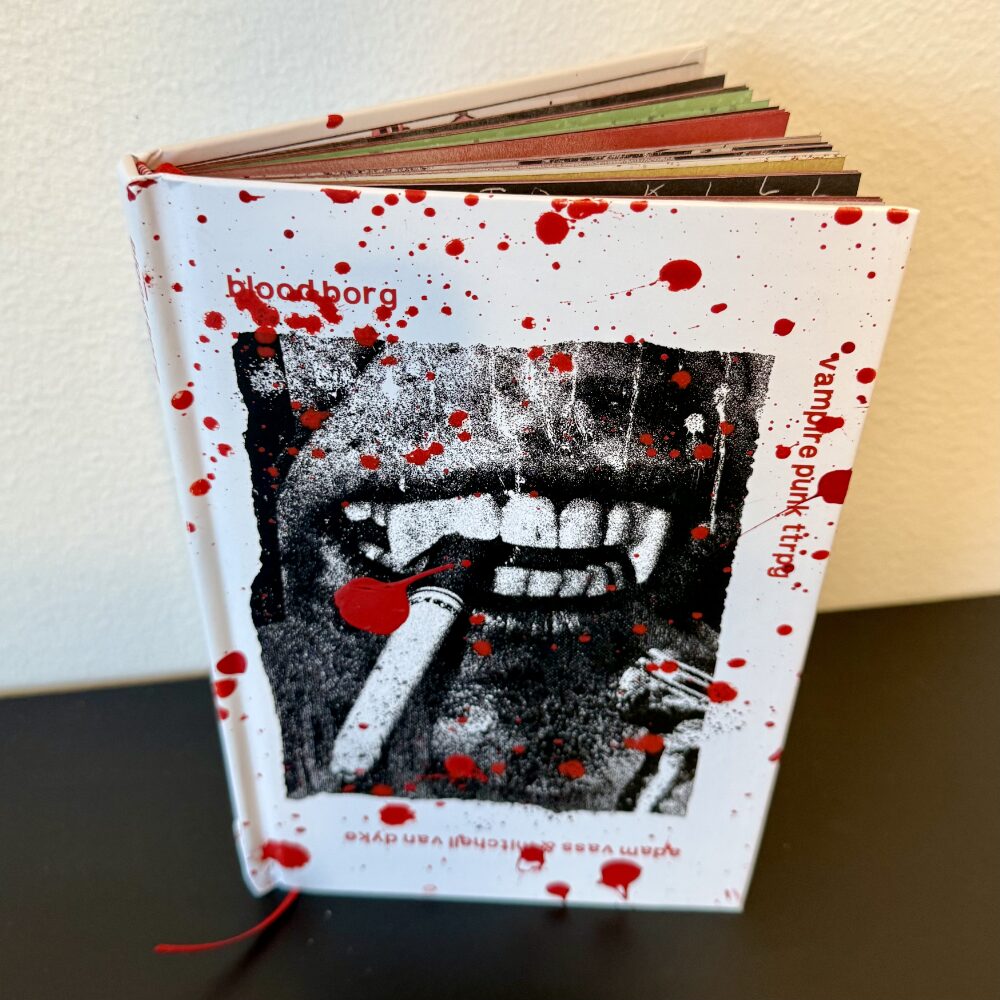Blood Borg is a modern, urban vampire take on Mörk Borg. It’s set in 198X, with players taking on the role of vampiric punks facing the society’s oppression as much as their own animal urges. The game began as its designer Adam Vass’s musing on what would Mörk Borg without character death look like.

Blood Borg does not have a looming apocalypse, like most Mörk Borg derivatives. Instead, the rapture has come and gone, and none of us left here on Earth noticed anything. The world has already ended, it’s just taking us a varying time to wake up to realize it. Instead: each vampire has their personal end of days looming, with a hunter after specifically them. So each vampire rolls a die every morning, and on a one, their hunter gets closer.
The game plays very fast and loose with its setting, the city of Scab, even for a Borg title, and I struggled to paint a cohesive picture for my players. If you’re not familiar with punk tropes, it can be tough to get into. There is a comprehensive design diary with cultural touchstones listed so you can see where the designer has pulled each element from. (Start from Lost Boys and Near Dark.)
Interestingly, this game doesn’t really exist in the bigger pool of vampire games, as Adam Vass has had zero experience with them when designing Blood Borg. Because they’re all based on the pop culture vampire from the Western tradition, the differences aren’t major, though. Coming from Vampire the Masquerade, myself, I find it notable that Blood Borg doesn’t really cover sex as part of the vampiric condition.
The book does a thorough job in introducing systems to drive the kind of play it wants to bring to the table. You get rules for traversal (by foot, own vehicle, or public transport), for dumpster diving, for doing drugs, for spell zines, and for factions. These are all good systems that create interesting situations, on top of being extremely thematic. They’re also all more than just random tables, usually with meaningful decisions and doubling down on (bad) luck. Great stuff.
My favorite detail is the way you can ignore a random encounter (which are not necessarily bad) on the route to somewhere by revealing truths about yourself in an introspective scene.
The biggest deviation from the Borg playbook is the way the vampire punks can support each other. They can freely aid a buddy, giving them a +1 on their roll, and doing so, they add “a promise” to the shared Squat Sheet. These promises can be cashed in by anyone in the crew for a reroll. The crew can bank three of these. This creates a situation where the player characters are at all times helping each other – very much in the punk spirit, and quite foreign to Borg games. I feel this kept the game from becoming an exercise in nihilism, even as human lives held close to zero value.
There’s a layout/design problem with the spell zines and curses that really bothered me during play: you can’t actually use them as d66 tables because they’re laid out as items numbered 1-36, and it takes a lot of counting to find the entry you want.
Something the game does very reliably is create funny and memorable moments, thanks to the great random tables and the unreliable outcome of any roll. Blood Borg’s random tables are exceptional, even if some of them could be expanded for more versatility. Especially the NPC table should be double length, at least. A great many of those funny moments are going to be morally dubious, and that just comes with the territory in a Borg game.
Production wise, this is a beautiful product. All the expansions are zines, and the visual identity is spot on. It looks, feels, reads, and plays like a Borg product, while being clearly its own thing, and not a Mörk Borg wannabe.
How did it go?
We played rules as written, creating random characters and then playing through the introductory adventure, where the vampires crash a human night club to find their missing room mate – a very on-theme, tiny dungeon crawl. This worked very well, especially when combined with the transit rules to get some additional color around the core. Vampires always needing more blood is a great, always-on motivation for characters to stay active in play.
In the second session I wanted to focus on all the background color we created during the first session, but didn’t really get to bring to the table as we were preoccupied with the dungeon crawl. This gave me the option to sample basically all the systems in the game without having to force anything. While this worked, the session lacked direction. I only gave the players a high level “there better be a party to go to by the weekend” concern, as well as a note that we’ve defined three factions in their neighborhood, and they’re all currently negative towards the player characters – by next week they’d be hostile, as all factions degrade weekly. Thus the players focused on coming up with ways to get these factions on their side. They did that, and it worked, but because it was a purely mechanical exercise, nobody cared very much about what was happening.
I don’t think this is the game’s fault. I should’ve grounded everything in dramatic characters, and I didn’t, mostly due to time concerns. At the same time: playing rules as written, there’s just a lot going on that demands the players’ attention, as well as takes up time both in the fiction and at the table. In an extended game, I’d take my foot off the pedal a bit, leaving more room for the character drama.
Blood Borg is a good Borg game. You should get it if you’re into Mörk Borg and curious about vampires or not dying in the game.
Leave a Reply